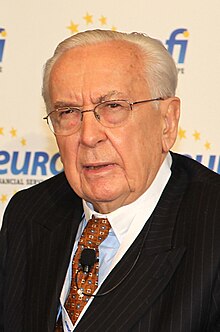Jacques de Larosière
Jacques de Larosière | |
|---|---|
 Larosière (right) with Timothy Geithner at a Eurofi event, 2011 | |
| President of the European Bank for Reconstruction and Development | |
| In office September 1993 – January 1998 | |
| Preceded by | Jacques Attali |
| Succeeded by | Horst Köhler |
| Governor of the Banque de France | |
| In office 1987–1993 | |
| Preceded by | Michel Camdessus |
| Succeeded by | Jean-Claude Trichet |
| Managing Director of the IMF | |
| In office 17 June 1978 – 15 January 1987 | |
| Preceded by | Johan Witteveen |
| Succeeded by | Michel Camdessus |
| Directeur du Trésor | |
| In office 1974–1978 | |
| Preceded by | Claude Pierre-Brossolette |
| Succeeded by | Jean-Yves Haberer |
| Personal details | |
| Born | 12 November 1929 Paris, France |
| Nationality | French |
| Education | Lycée Louis-le-Grand |
| Alma mater | Sciences Po, ÉNA |
| Profession | Civil servant |
This article needs additional citations for verification. (April 2020) |
Jacques de Larosière de Champfeu (born 12 November 1929 in Paris) is a French former central banker and public official.
Family and education[]
Larosière descends from Joseph Thebaud.[citation needed] He studied at Lycée Louis-le-Grand and Institut d'Etudes Politiques de Paris. He graduated from École nationale d'administration in 1958 and entered the elite French Finance Ministry internal inspectorate known as the Inspection générale des finances.
Career[]
From 1965 to 1974 Larosière worked at the within the French Finance Ministry. He then briefly joined the private office (cabinet) of Finance Minister Valéry Giscard d'Estaing, and following the latter election as French President, was appointed Director of the French Treasury in 1974, a position he held for the next four years.
He was then the Managing Director of the International Monetary Fund (IMF) from 17 June 1978 to 15 January 1987.
From 1987 to 1993 he was the Governor of the Banque de France.
In September 1993 Larosière became President of the London-based European Bank for Reconstruction and Development, in the wake of the scandals that led to the departure of the EBRD's first president, Jacques Attali. He left this position in 1998 after restoring the bank's reputation and credibility.
In the wake of the Bankruptcy of Lehman Brothers, European Commission President José Manuel Barroso asked Larosière to lead a high-level group that in February 2009 produced a landmark report, known as the "Larosière Report" and recommending a broad overhaul of the European Union financial regulatory architecture.[1] The Larosiere Report's suggestions were adopted in EU legislation enacted in 2010 that created the European Banking Authority, the European Insurance and Occupational Pensions Authority, the European Securities and Markets Authority, and the European Systemic Risk Board.
As of 2021 he remains Chairman of the Strategic Committee of the French debt management office, the , and advisor to BNP Paribas.
Policy advocacy[]
In 1992 Larosière became a member of the Washington-based Group of Thirty. In 2000 he co-created Eurofi and became its co-chair together with , then sole chair from 2011 to 2016.
Honours[]
 Grand Officer of the Legion of Honour
Grand Officer of the Legion of Honour Order of the Cross of Terra Mariana, 2nd Class
Order of the Cross of Terra Mariana, 2nd Class Honorary Knight Commander of The Most Excellent Order of the British Empire[2]
Honorary Knight Commander of The Most Excellent Order of the British Empire[2]
References[]
- ^ Castle, Stephen (February 25, 2009), "European Panel Seeks Closer Supervision of Banks", New York Times
- ^ "Honorary Knighthoods Awarded 1997-2006".
- 1929 births
- Living people
- Lycée Louis-le-Grand alumni
- Sciences Po alumni
- École nationale d'administration alumni
- Inspection générale des finances (France)
- Governors of the Banque de France
- Managing directors of the International Monetary Fund
- BNP Paribas people
- Recipients of the Order of the Cross of Terra Mariana, 2nd Class
- Members of the Académie des sciences morales et politiques
- Grand Officiers of the Légion d'honneur
- Honorary Knights Commander of the Order of the British Empire
- Presidents of the European Bank for Reconstruction and Development
- French officials of the United Nations
- French business biography stubs